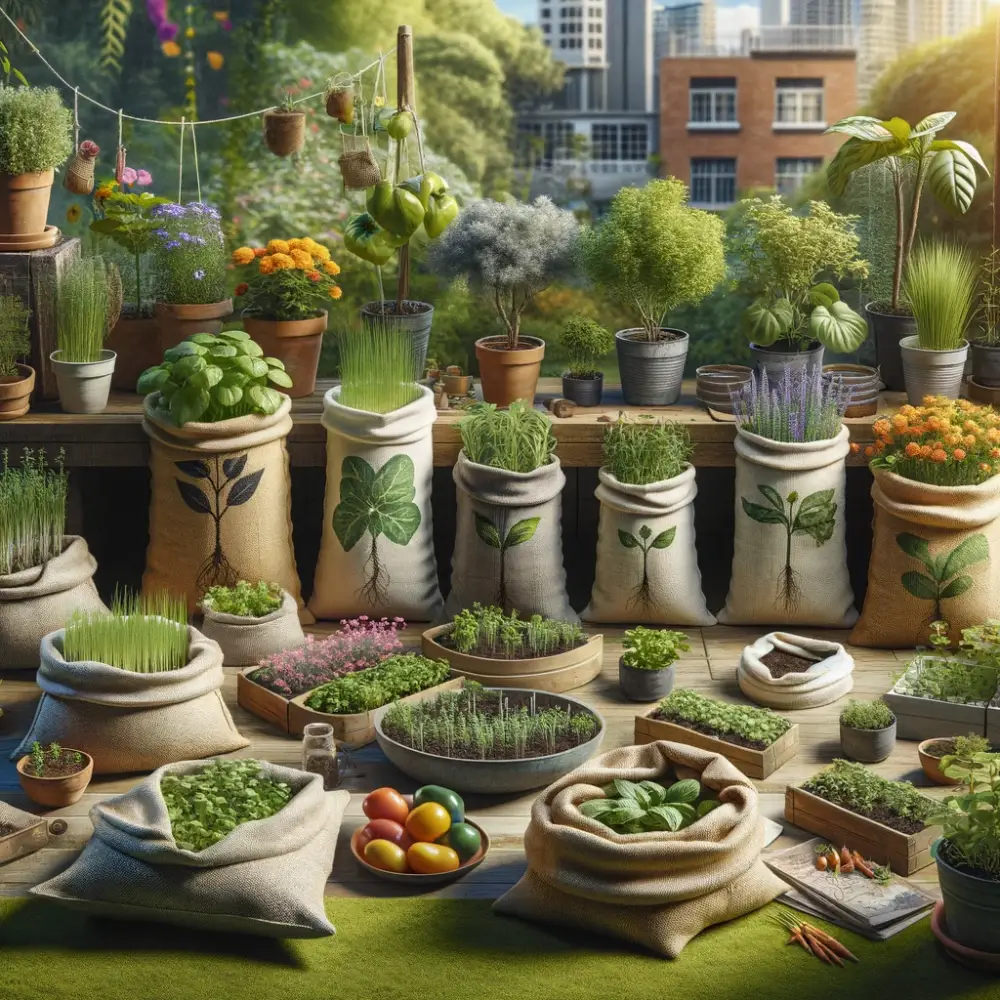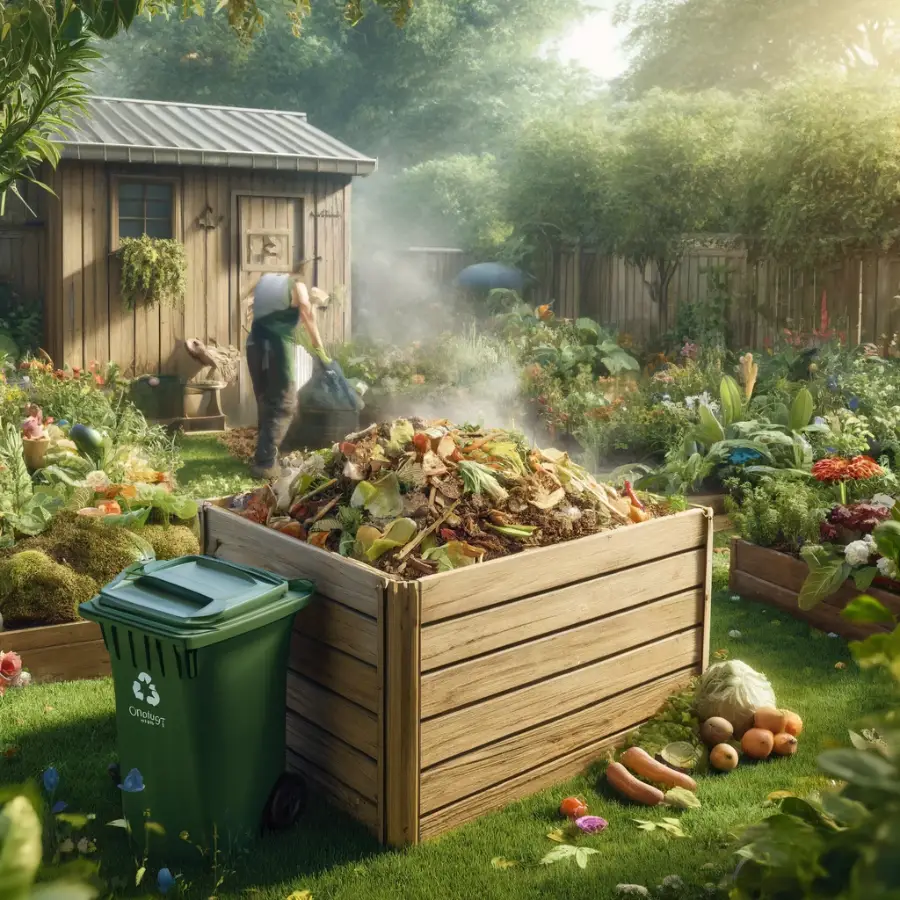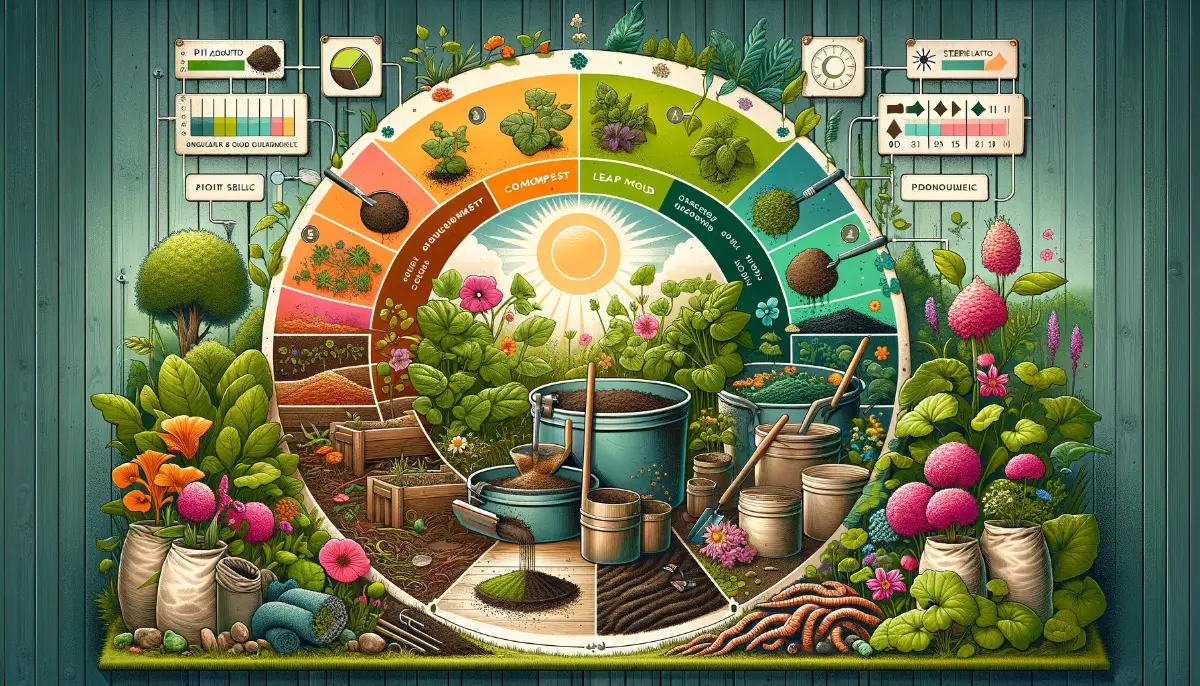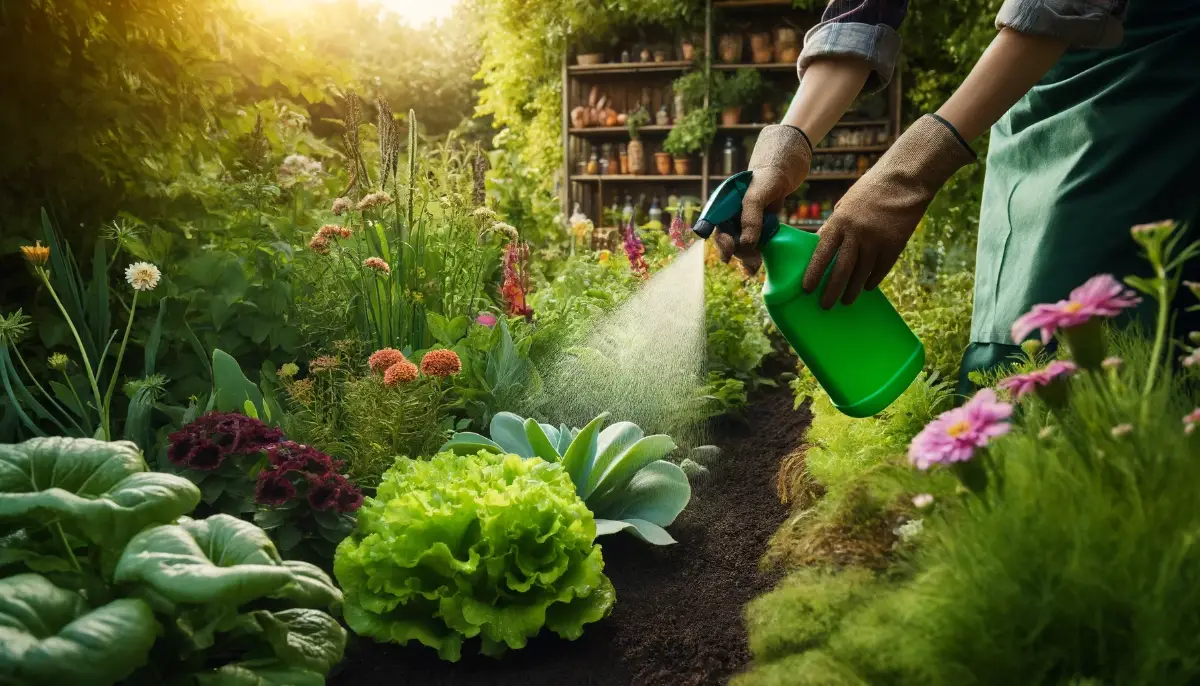Organic fabric grow bags are a sustainable gardening alternative to traditional plastic pots. Made from natural, biodegradable materials such as jute, cotton, or hemp, these grow bags provide an eco-friendly solution for cultivating a variety of plants.
Their porous nature allows for better air circulation and drainage, fostering healthier root systems and promoting robust plant growth.
Grow bags enhance root aeration and prevent common issues such as root circling and overwatering, leading to healthier plants. Additionally, they are versatile and can be used in various settings, from small urban gardens to large-scale agricultural operations.
Types of Organic Fabric Grow Bags
Materials Used
Organic fabric grow bags come in a variety of materials, each with unique properties that cater to different gardening needs. The most common materials include:
Jute
- A natural fiber known for its durability and breathability
- Offers excellent drainage and aeration
- Biodegradable and environmentally friendly
Cotton
- Soft and lightweight, providing good root comfort
- Highly breathable, promoting better air circulation
- Compostable and sustainable
Hemp
- Extremely strong and durable, with natural resistance to pests and mold
- Excellent water retention and drainage balance
- Eco-friendly, as hemp cultivation requires fewer resources
Comparison of Materials
Durability
- Hemp is the most durable, suitable for long-term use
- Jute and cotton are slightly less durable but still robust enough for multiple growing seasons
Permeability
- Cotton offers the highest permeability, followed by jute and hemp
- High permeability materials are ideal for plants requiring excellent root aeration
Cost
- Cotton is generally the least expensive, while hemp tends to be more costly due to its superior durability and performance
- Jute falls in the middle, offering a balance between cost and benefits
Sizes and Shapes
Organic fabric grow bags are available in a range of sizes and shapes to accommodate different types of plants and gardening setups.
Small Sizes (1-3 gallons)
- Suitable for herbs, small flowers, and seedlings
- Ideal for indoor gardening or small balcony setups
Medium Sizes (5-10 gallons)
- Perfect for medium-sized vegetables like tomatoes, peppers, and root crops
- Versatile for both indoor and outdoor use
Large Sizes (15+ gallons)
- Best for larger plants, shrubs, and small trees
- Often used in outdoor gardens and urban farming projects
Special Shapes for Specific Gardening Needs
Round Bags
- The most common shape, suitable for general use
- Allows for even root growth in all directions
Rectangular and Square Bags
- Ideal for maximizing space in raised beds and garden rows
- Provide more planting area in confined spaces
Hanging Bags
- Designed for vertical gardening and maximizing vertical space
- Great for strawberries, herbs, and small trailing plants
By choosing the right type of organic fabric grow bag, gardeners can optimize their growing conditions, cater to the specific needs of their plants, and contribute to a more sustainable gardening practice.
How to Use Organic Fabric Grow Bags
Choosing the Right Size and Material
Choosing the right size and material for organic fabric grow bags is crucial for ensuring optimal plant growth and health. The appropriate size provides adequate space for root development, preventing issues like root circling and promoting robust growth.
Selecting the right material influences water retention, aeration, and durability, directly impacting the plant’s overall well-being and the grow bag’s longevity.
Preparing the Soil Mix
Soil: Use high-quality, well-draining potting soil. A mix of compost, peat moss, and perlite or vermiculite works well.
Amendments: Add organic fertilizers, such as compost, worm castings, or fish emulsion, to enrich the soil and provide essential nutrients.
Hydration: Moisten the soil mix before filling the grow bag to ensure even moisture distribution.
Planting Techniques
Planting Seeds
- Fill the grow bag with the prepared soil mix, leaving about 1-2 inches of space from the top.
- Sow seeds according to the depth and spacing recommendations on the seed packet.
- Cover seeds lightly with soil and water gently.
Transplanting Seedlings
- Dig a hole in the prepared soil mix to accommodate the seedling’s root ball.
- Carefully remove the seedling from its original container, handling it by the leaves to avoid damaging the stem.
- Place the seedling in the hole and fill in with soil, firming it gently around the base.
- Water thoroughly to settle the soil around the roots.
Optimal Plant Spacing
- Follow the spacing recommendations for each plant type to ensure adequate air circulation and root growth.
- Overcrowding can lead to poor growth and increased susceptibility to diseases.
Maintenance
Watering Guidelines
- Organic fabric grow bags dry out faster than traditional pots, so monitor soil moisture regularly.
- Water deeply and thoroughly until water drains out from the bottom of the bag.
- Adjust watering frequency based on plant needs and environmental conditions.
Fertilization Tips
- Use organic fertilizers to maintain soil fertility and support healthy plant growth.
- Apply liquid fertilizers, like fish emulsion or compost tea, every 2-4 weeks during the growing season.
- Top-dress with compost or organic mulch to retain moisture and provide slow-release nutrients.
Seasonal Care and Storage
- In colder climates, consider bringing grow bags indoors or protecting them with frost blankets.
- At the end of the growing season, empty the soil from the grow bags and clean them thoroughly.
- Store grow bags in a dry, cool place to prevent mold and extend their lifespan.
By following these steps, gardeners can effectively use organic fabric grow bags to cultivate a wide variety of plants, ensuring healthy growth and contributing to sustainable gardening practices.
Comparing Organic Fabric Grow Bags to Traditional Pots
Mobility and Flexibility
Ease of Moving and Rearranging
- Organic fabric grow bags are lightweight and flexible, making them easier to move around compared to heavy traditional pots.
- They can be easily rearranged to optimize sunlight exposure or to accommodate changes in garden layout.
- Their flexibility allows them to be folded and stored compactly when not in use, unlike rigid pots that take up more storage space.
Space Efficiency
Better Use of Small or Limited Spaces
- Grow bags can fit into tighter spaces, maximizing the use of small gardens, balconies, and urban farming areas.
- They can be placed closer together without compromising plant health due to their breathability, which ensures proper air circulation.
- Vertical gardening with hanging or stackable grow bags allows for more plants in a limited area, enhancing space efficiency.
Plant Health
Differences in Root Growth and Health
- Fabric grow bags promote healthier root systems by allowing air pruning, which encourages the growth of fibrous roots and prevents root circling.
- Enhanced aeration and drainage provided by fabric grow bags reduce the risk of overwatering and root rot, common problems with traditional pots.
- The porous nature of fabric grow bags maintains better soil oxygenation, which is essential for optimal nutrient uptake and plant growth.
Challenges and Solutions
Common Issues
- Potential for Drying Out Quickly: Organic fabric grow bags can dry out faster than traditional pots because of their breathable nature. This can lead to plants not getting enough water if not monitored properly.
- Structural Integrity Over Time: Fabric grow bags may wear out or degrade over time, especially when exposed to harsh weather conditions or frequent handling. This can reduce their lifespan and effectiveness.
- Pests and Disease Management: Fabric grow bags can sometimes be more susceptible to pests and diseases due to their proximity to the ground and the permeability of the fabric, which might allow pests to enter more easily.
Addressing Problems
Maintaining Moisture
- Use mulch on the surface of the soil to help retain moisture and reduce evaporation.
- Install a drip irrigation system or self-watering wicks to ensure consistent moisture levels.
- Water the grow bags more frequently but monitor the soil moisture to avoid overwatering.
Prolonging the Lifespan of Grow Bags
- Choose high-quality materials like hemp, which are more durable and resistant to wear and tear.
- Avoid dragging the bags on rough surfaces and handle them gently to prevent fabric damage.
- Store the grow bags indoors during off-seasons or harsh weather conditions to protect them from UV damage and extreme temperatures.
Pest and Disease Prevention
- Place grow bags on raised platforms or stands to reduce contact with the ground and potential pests.
- Use organic pest control methods such as neem oil, diatomaceous earth, or beneficial insects to manage pests.
- Practice good garden hygiene by removing dead leaves and debris, rotating crops, and using disease-resistant plant varieties.
FAQs: Organic Fabric Grow Bags
What are organic fabric grow bags made of?
Organic fabric grow bags are typically made from natural, biodegradable materials such as jute, cotton, or hemp. These materials are chosen for their breathability, durability, and environmental friendliness.
Why should I use organic fabric grow bags instead of traditional plastic pots?
Organic fabric grow bags offer better root aeration, improved drainage, and reduced risk of root circling. They are also environmentally friendly, being biodegradable and reducing plastic waste.
How do I choose the right size grow bag for my plants?
The size of the grow bag depends on the type of plant and its growth requirements. Smaller bags (1-3 gallons) are suitable for herbs and small plants, medium bags (5-10 gallons) for vegetables and flowers, and larger bags (15+ gallons) for shrubs and small trees.
Do organic fabric grow bags dry out faster than traditional pots?
Yes, due to their breathable nature, organic fabric grow bags can dry out faster. It’s important to monitor soil moisture regularly and water more frequently if needed.
Can I reuse organic fabric grow bags?
Yes, organic fabric grow bags can be reused for multiple growing seasons. Proper care, such as cleaning and storing them properly during the off-season, can extend their lifespan.
Are organic fabric grow bags suitable for all types of plants?
Organic fabric grow bags are versatile and can be used for a wide variety of plants, including herbs, vegetables, flowers, and small trees. However, they are particularly beneficial for plants that require good drainage and root aeration.
How do I maintain the moisture level in organic fabric grow bags?
To maintain moisture, use mulch to reduce evaporation, install a drip irrigation system or self-watering wicks, and water more frequently based on the plant’s needs.
What are the common challenges of using organic fabric grow bags, and how can they be addressed?
Common challenges include faster drying out, structural degradation, and increased susceptibility to pests. These can be addressed by using mulch, choosing durable materials, handling bags gently, and using organic pest control methods.
Can organic fabric grow bags be used indoors?
Yes, organic fabric grow bags can be used indoors. They are ideal for indoor gardening due to their lightweight and flexible nature, making them easy to move and manage.










